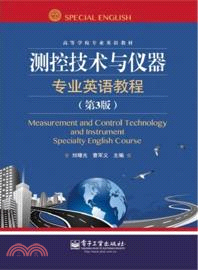測控技術與儀器專業英語教程(第3版)(簡體書)
商品資訊
系列名:高等學校專業英語教材
ISBN13:9787121210334
出版社:電子工業出版社
作者:劉曙光
出版日:2013/08/01
裝訂:平裝
商品簡介
作者簡介
名人/編輯推薦
序
目次
相關商品
商品簡介
劉曙光、曹軍義主編的《測控技術與儀器專業英語教程(第3版)》旨在使讀者掌握測控技術與儀器專業英語術語及用法,培養和提高讀者閱讀和翻譯專業英語文獻資料的能力;主要內容包括電子技術、數字系統、信號處理、測試技術、儀器儀表、遙感通信等。本書由16
篇課文和16篇閱讀材料組成,并附有所有課文的參考譯文。
為了方便教學,本書配有電子教案,向采納本書作為教材的教師免費提供。
《測控技術與儀器專業英語教程(第3版)》可以作為測控技術與儀器專業的專業英語課程教材,也可供從事相關專業的工程技術人員學習參考。
作者簡介
劉曙光,西安工程大學電信學院教授,出版教材3本,在國內外核心期刊上發表論文100余篇,其中有15篇論文分別被EI及ISTP檢索。獲國家教委科技進步三等獎1項,獲國家發明專利2項、實用新型專利2項,其中1項專利曾獲2001年香港國際專利博覽會金獎和倫敦國際專利博覽會金獎。2001年9月被陜西省教育廳、人事廳評為陜西省優秀留學回國人員。現為學校的學科帶頭人。
名人/編輯推薦
本書選材廣泛,結構體系完整,課后配有專業詞匯、注釋及練習,每課均有參考譯文,全書配有電子教案、習題答案、授課建議等教輔資源免費提供授課教師參考。另外,本書作者有很好的寫作基礎。上一版共印10000冊。
序
前言
隨著信息化社會進程的不斷加快,越來越多的人們認識到語言已成為獲取信息的重要手段。為了更快、更準確地了解本專業的發展動向,應學習和借鑒國外的先進技術和有效管理經驗。閱讀和翻譯專業英語文獻資料的能力已經成為高等學校師生及科研工作者所必備的素質之一。
目前,學生們在完成大學公共英語課程的學習之后,要想順利閱讀本專業的英語書刊、文獻尚存在著不少困難。教育部頒布的“大學英語教學大綱”把專業英語閱讀列為必修課而納入英語教學計劃,強調通過四年的教學使學生達到順利閱讀專業刊物的目的。根據這一精神,我們編寫了本書,以滿足測控技術與儀器專業學生學習的需要,也可供從事上述專業的工程技術人員學習參考。
本書由16篇課文和16篇閱讀材料組成,涉及的內容包括:電子技術、數字系統、信號處理、測試技術、儀器儀表、遙感通信等。課文內容新穎,文體規范,難度適中。為了適應專業英語的教學要求,書中所涉及的內容既對學生所學過的課程進行了必要的覆蓋,又有所拓寬和延伸,力求反映測控技術與儀器的現狀和發展趨勢,既可提高讀者英語閱讀水平,又能使讀者了解學科前沿。為了方便教學,本書另配有電子教案,向采納本書作為教材的教師免費提供
本書由劉曙光、曹軍義主編,參加編寫的有費佩燕、屈萍鴿、侯志敏、郭亞青、張莉。
由于水平有限,書中難免有不足和欠妥之處,懇請廣大讀者批評指正。
編者
隨著信息化社會進程的不斷加快,越來越多的人們認識到語言已成為獲取信息的重要手段。為了更快、更準確地了解本專業的發展動向,應學習和借鑒國外的先進技術和有效管理經驗。閱讀和翻譯專業英語文獻資料的能力已經成為高等學校師生及科研工作者所必備的素質之一。
目前,學生們在完成大學公共英語課程的學習之后,要想順利閱讀本專業的英語書刊、文獻尚存在著不少困難。教育部頒布的“大學英語教學大綱”把專業英語閱讀列為必修課而納入英語教學計劃,強調通過四年的教學使學生達到順利閱讀專業刊物的目的。根據這一精神,我們編寫了本書,以滿足測控技術與儀器專業學生學習的需要,也可供從事上述專業的工程技術人員學習參考。
本書由16篇課文和16篇閱讀材料組成,涉及的內容包括:電子技術、數字系統、信號處理、測試技術、儀器儀表、遙感通信等。課文內容新穎,文體規范,難度適中。為了適應專業英語的教學要求,書中所涉及的內容既對學生所學過的課程進行了必要的覆蓋,又有所拓寬和延伸,力求反映測控技術與儀器的現狀和發展趨勢,既可提高讀者英語閱讀水平,又能使讀者了解學科前沿。為了方便教學,本書另配有電子教案,向采納本書作為教材的教師免費提供
本書由劉曙光、曹軍義主編,參加編寫的有費佩燕、屈萍鴿、侯志敏、郭亞青、張莉。
由于水平有限,書中難免有不足和欠妥之處,懇請廣大讀者批評指正。
編者
目次
Contents
Lesson 1 Periodic Signals
1.1 TimeDomain Description
1.2 FrequencyDomain Description
1.3 Orthogonal Functions
1.4 The Fourier Series
Exercises
Reading Material:Underwater Acoustic Signal
Lesson 2 Aperiodic Signals
2.1 Introduction
2.2 The Exponential Form of the Fourier Series
2.3 The Fourier Transform
2.4 The Laplace Transform
Exercises
Reading Material:Properties of Signal and Noise
Lesson 3 SampledData Signals
3.1 Introduction
3.2 Mathematical Description Using the Dirac Function
3.3 Spectra of Sampleddata Signals
3.4 The ztransform
Exercises
Reading Material:Signal Sampling
Lesson 4 Random Signals
4.1 Introduction
4.2 Elements of Probability Theory
4.3 Amplitude Distribution and Moments
4.4 The Autocorrelation and Power Spectral Density
Exercises
Reading Material:The Processing of Random Signal
Lesson 5 Static Performance
5.1 The Ideal Measuring System
5.2 Sensitivity
5.3 Accuracy and Precision
5.4 Possible and Probable Errors
5.5 Other StaticPerformance Terms
Exercises
Reading Material:Noncontact Temperature Measurement
Lesson 6 Dynamic Performance
6.1 Zeroorder Systems
6.2 Firstorder Systems
6.3 Secondorder Systems
6.4 Stepresponse Specification
6.5 Frequencyresponse Specification
Exercises
Reading Material:Eddy Current
Lesson 7 Basic Knowledge of Transducers and Resistance Transducers
7.1 Transducer Elements
7.2 Transducer Sensitivity
7.3 Characteristics of an Ideal Transducer
7.4 Electrical Transducers
7.5 Resistance Transducers
Exercises
Reading Material:Laser
Lesson 8 Capacitance, Inductance Transducers and Some Others
8.1 Capacitive Transducers
8.2 Inductive Transducers
8.3 Linear Variabledifferential Transformer(l.v.d.t.)
8.4 Piezoelectric Transducers
8.5 Electromagnetic Transducers
8.6 Thermoelectric Transducers
8.7 Photoelectric Cells (selfgenerating)
8.8 Mechanical Transducers and Sensing Elements
Exercises
Reading Material:Video Camera
Lesson 9 Analog Instruments
9.1 Meter Basics
9.2 Ammeters
9.3 Current Measuring Errors
9.4 DC Voltmeters
9.5 Voltage Measuring Errors
9.6 Ohmmeter and Resistance Measurements
9.7 Series Ohmmeter
9.8 Shunt Ohmmeter
9.9 Ohmmeter Accuracy
9.10 VoltOhmMilliammeters
9.11 Electronic Voltmeters
9.12 Transistorized Electronic Voltmeters
9.13 FET Voltmeters
9.14 Operational Amplifier Electronic Voltmeters
9.15 Electronic Current Measurements
9.16 Resistance Measurements
Exercises
Reading Material:Rectifier Meters
Lesson 10 Digital Instruments
10.1 Digital Displays
10.2 Electronic Digital Counter
10.3 Input Signal Conditioning
10.4 Timerbase Oscillator
10.5 Timerbase Dividers
10.6 Counting Register
10.7 Digital Voltmeter
Exercises
Reading Material:Risetime Measurements
Lesson 11 Computerbased Test Instruments
11.1 Internal Adapters
11.2 External PC Instruments
11.3 AnalogtoDigital Conversion
11.4 Computer Interface
11.5 Generalpurpose Interface BUS
Exercises
Reading Material:PCbased Workstation
Lesson 12 Industrial Bus
12.1 What is An Industrial Bus
12.2 Data Line Isolation Theory
Exercises
Reading Material: Serial Communications Systems
Lesson 13 Programmable Logic Controller
13.1 Basic PLC Operation
13.2 HardWired Control
13.3 Advantages of PLCs
13.4 Siemens PLCs
13.5 CPU
13.6 Programming Devices
13.7 Software
13.8 Connector Cables PPI (PointtoPoint Interface)
Exercises
Reading Material: Terminology
Lesson 14 Remote Sensing
14.1 Sensors
14.2 Satellites
14.3 Outlook
Exercises
Reading Material:GPS
Lesson 15 Multisensor Data Fusion
151 Introduction
152 Technical Background
153 Method
154 Application
Exercises
Reading Material:Multisensor Image Fusion
Lesson 16 Process Control System
16.1 A Process Control System
16.2 Fundamentals of Process Control
Exercises
Reading Material: Final Control Elements and Controllers
參考譯文
第1課 周期信號
第2課 非周期信號
第3課 數據采樣信號
第4課 隨機信號
第5課 靜態性能
第6課 動態性能
第7課 傳感器和電阻式傳感器的基礎知識
第8課 電容式、電感式傳感器及其他
第 9課 模擬儀器
第10課 數字儀器
第11課 基于計算機的測試儀器
第12課 工業總線
第13課 可編程邏輯控制器
第14課 遙感
第15課 多傳感器數據融合
第16課 過程控制系統
參考文獻
Lesson 1 Periodic Signals
1.1 TimeDomain Description
1.2 FrequencyDomain Description
1.3 Orthogonal Functions
1.4 The Fourier Series
Exercises
Reading Material:Underwater Acoustic Signal
Lesson 2 Aperiodic Signals
2.1 Introduction
2.2 The Exponential Form of the Fourier Series
2.3 The Fourier Transform
2.4 The Laplace Transform
Exercises
Reading Material:Properties of Signal and Noise
Lesson 3 SampledData Signals
3.1 Introduction
3.2 Mathematical Description Using the Dirac Function
3.3 Spectra of Sampleddata Signals
3.4 The ztransform
Exercises
Reading Material:Signal Sampling
Lesson 4 Random Signals
4.1 Introduction
4.2 Elements of Probability Theory
4.3 Amplitude Distribution and Moments
4.4 The Autocorrelation and Power Spectral Density
Exercises
Reading Material:The Processing of Random Signal
Lesson 5 Static Performance
5.1 The Ideal Measuring System
5.2 Sensitivity
5.3 Accuracy and Precision
5.4 Possible and Probable Errors
5.5 Other StaticPerformance Terms
Exercises
Reading Material:Noncontact Temperature Measurement
Lesson 6 Dynamic Performance
6.1 Zeroorder Systems
6.2 Firstorder Systems
6.3 Secondorder Systems
6.4 Stepresponse Specification
6.5 Frequencyresponse Specification
Exercises
Reading Material:Eddy Current
Lesson 7 Basic Knowledge of Transducers and Resistance Transducers
7.1 Transducer Elements
7.2 Transducer Sensitivity
7.3 Characteristics of an Ideal Transducer
7.4 Electrical Transducers
7.5 Resistance Transducers
Exercises
Reading Material:Laser
Lesson 8 Capacitance, Inductance Transducers and Some Others
8.1 Capacitive Transducers
8.2 Inductive Transducers
8.3 Linear Variabledifferential Transformer(l.v.d.t.)
8.4 Piezoelectric Transducers
8.5 Electromagnetic Transducers
8.6 Thermoelectric Transducers
8.7 Photoelectric Cells (selfgenerating)
8.8 Mechanical Transducers and Sensing Elements
Exercises
Reading Material:Video Camera
Lesson 9 Analog Instruments
9.1 Meter Basics
9.2 Ammeters
9.3 Current Measuring Errors
9.4 DC Voltmeters
9.5 Voltage Measuring Errors
9.6 Ohmmeter and Resistance Measurements
9.7 Series Ohmmeter
9.8 Shunt Ohmmeter
9.9 Ohmmeter Accuracy
9.10 VoltOhmMilliammeters
9.11 Electronic Voltmeters
9.12 Transistorized Electronic Voltmeters
9.13 FET Voltmeters
9.14 Operational Amplifier Electronic Voltmeters
9.15 Electronic Current Measurements
9.16 Resistance Measurements
Exercises
Reading Material:Rectifier Meters
Lesson 10 Digital Instruments
10.1 Digital Displays
10.2 Electronic Digital Counter
10.3 Input Signal Conditioning
10.4 Timerbase Oscillator
10.5 Timerbase Dividers
10.6 Counting Register
10.7 Digital Voltmeter
Exercises
Reading Material:Risetime Measurements
Lesson 11 Computerbased Test Instruments
11.1 Internal Adapters
11.2 External PC Instruments
11.3 AnalogtoDigital Conversion
11.4 Computer Interface
11.5 Generalpurpose Interface BUS
Exercises
Reading Material:PCbased Workstation
Lesson 12 Industrial Bus
12.1 What is An Industrial Bus
12.2 Data Line Isolation Theory
Exercises
Reading Material: Serial Communications Systems
Lesson 13 Programmable Logic Controller
13.1 Basic PLC Operation
13.2 HardWired Control
13.3 Advantages of PLCs
13.4 Siemens PLCs
13.5 CPU
13.6 Programming Devices
13.7 Software
13.8 Connector Cables PPI (PointtoPoint Interface)
Exercises
Reading Material: Terminology
Lesson 14 Remote Sensing
14.1 Sensors
14.2 Satellites
14.3 Outlook
Exercises
Reading Material:GPS
Lesson 15 Multisensor Data Fusion
151 Introduction
152 Technical Background
153 Method
154 Application
Exercises
Reading Material:Multisensor Image Fusion
Lesson 16 Process Control System
16.1 A Process Control System
16.2 Fundamentals of Process Control
Exercises
Reading Material: Final Control Elements and Controllers
參考譯文
第1課 周期信號
第2課 非周期信號
第3課 數據采樣信號
第4課 隨機信號
第5課 靜態性能
第6課 動態性能
第7課 傳感器和電阻式傳感器的基礎知識
第8課 電容式、電感式傳感器及其他
第 9課 模擬儀器
第10課 數字儀器
第11課 基于計算機的測試儀器
第12課 工業總線
第13課 可編程邏輯控制器
第14課 遙感
第15課 多傳感器數據融合
第16課 過程控制系統
參考文獻
主題書展
更多
主題書展
更多書展今日66折
您曾經瀏覽過的商品
購物須知
大陸出版品因裝訂品質及貨運條件與台灣出版品落差甚大,除封面破損、內頁脫落等較嚴重的狀態,其餘商品將正常出貨。
特別提醒:部分書籍附贈之內容(如音頻mp3或影片dvd等)已無實體光碟提供,需以QR CODE 連結至當地網站註冊“並通過驗證程序”,方可下載使用。
無現貨庫存之簡體書,將向海外調貨:
海外有庫存之書籍,等候約45個工作天;
海外無庫存之書籍,平均作業時間約60個工作天,然不保證確定可調到貨,尚請見諒。
為了保護您的權益,「三民網路書店」提供會員七日商品鑑賞期(收到商品為起始日)。
若要辦理退貨,請在商品鑑賞期內寄回,且商品必須是全新狀態與完整包裝(商品、附件、發票、隨貨贈品等)否則恕不接受退貨。
優惠價:87
198
海外經銷商無庫存,到貨日平均30天至45天
























